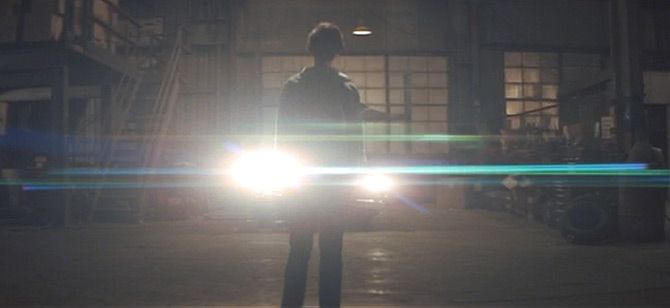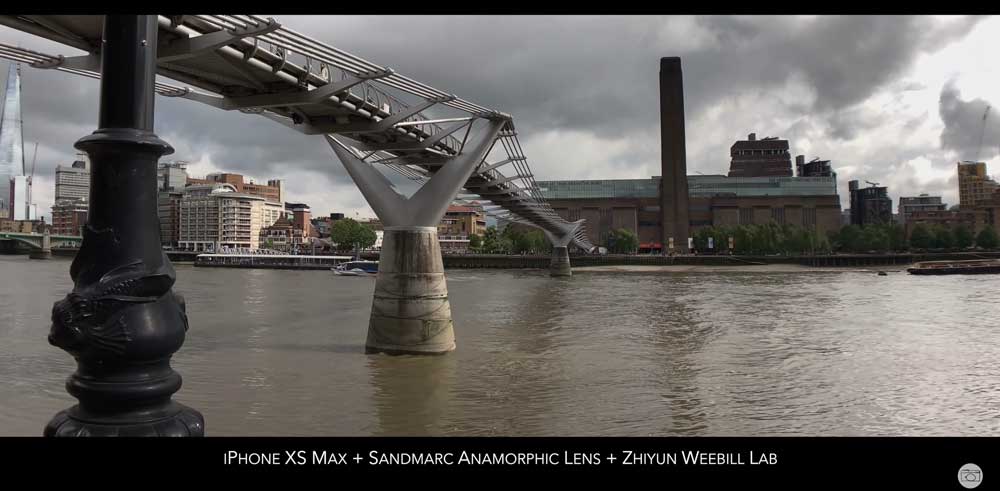New Sandmarc Anamorphic Lens
Sandmarc are one of the best conversion lens makers for iPhone. Their lenses are usually mounted using their custom designed case, like Moment. However, they also come with a general purpose clip – so my guess is they can be used with other brands of smartphone too.
Sandmarc been developing photography gear for Apple, DJI, and GoPro for 5 years. But now they’ve released a new lens for iPhone: the SANDMARC Anamorphic Lens.
Anamorphic lenses capture a wide image, but unlike a regular wide angle lense they only widen the field of view sideways. In other words, you can see more from left and right, but up and down remain as without the lens.
De-squeezing
When you add an anamorphic conversion to your smartphone, the wider image is “squeezed” onto the regular 16×9 frame. This means everything is distorted to look thinner until you “de-squeeze” the image. Camera apps like FiLMiC Pro have a setting which de-squeezes the image directly so you can see what you are filming. Otherwise, you can de-squeeze the video in an editing program like Adobe Premiere after filming.
Anamorphic is designed for film and video
Anamorphic lenses were invented decades ago, when Hollywood studios were worried about losing audiences to TV screens. To make cinema stand out again, they decided to go WIDESCREEN.
But rather than reinvent film, film cameras and projectors, they simply developed a lens which would squeeze a wider image onto standard 35mm film. Meanwhile, an adapter for cinema projectors did the de-squeezing part.
So, that’s why anamorphic lenses are more for smartphone videographers than stills photographers.
Lens flares too
One of the reasons smartphone filmmakers get excited by anamorphic lenses, is that they can produce distinctive lens flares. Due to the barrel-like shape of the lens, anamorphic flares shoot out sideways from light sources in the frame.
This is effect is particularly noticeable in night shots with characters using flashlights…
The Sandmarc Anamorphic Lens comes with an iPhone case, clip-on mount, lens cap, and pouch currently priced at $159.99. This is roughly the same as Moment’s anamorphic, taking into account the cost of the case mount.
Why I like an anamorphic conversion lens
For me, the anamorphic widescreen look is what sets it apart from other lenses and why I would use one. For video especially, this type of lens really gives your smartphone footage a special look at relatively low cost.
The lens flares are the obvious “crowd-pleaser” but that’s not what I get excited about. Rather, it’s more about the subtle change in the look of the video. You could simply crop off the top and bottom of the image, but that just doesn’t look the same.
To be honest, I find it difficult to explain what it is about the image which is appealing. The format somehow makes the video look grander without causing too much fish-eye style distortion.
What do you think? If you use an anamorphic lens, let us know why you like it in the comments below.
This anamorphic lens looks like a very good piece of kit, like other Sandmarc lenses. However, personally I’d still stick with a Moondog Labs anamorphic even at a slightly higher cost.
Check out this great review of the new Sandmarc lens, with some good test footage. He also points out some problems using ND filters mounted onto the anamorphic lens.
Eager to learn more?
Join our weekly newsletter featuring inspiring stories, no-budget filmmaking tips and comprehensive equipment reviews to help you turn your film projects into reality!
Simon Horrocks
Simon Horrocks is a screenwriter & filmmaker. His debut feature THIRD CONTACT was shot on a consumer camcorder and premiered at the BFI IMAX in 2013. His shot-on-smartphones sci-fi series SILENT EYE featured on Amazon Prime. He now runs a popular Patreon page which offers online courses for beginners, customised tips and more: www.patreon.com/SilentEye




It’s a shame there’s no company in the UK making these anamorphic lenses. The cost shoots up when taking shipping and import duties into consideration. It’s another reason I chose to get the Xperia 1, no need for an anamorphic lens due to the 21.9 aspect ratio, albeit minus the lens flare.
You mean it’s time for MoMo to start making lenses?
Sounds like a great idea to me Simon!